Books
Books

A Working Life (paperback)
The first new collection since Evolution from the prolific poet, activist, and writer Eileen Myles, a “Working Life” unerringly captures the measure of life. Whether alone or in relationship, on city sidewalks or in the country, their lyrics always engage with permanence and mortality, danger and safety, fear and wonder.
a “Working Life” is a book transfixed by the everyday: the “sweet accumulation” of birds outside a window, a cup of coffee and a slice of pizza, a lover’s foot on the bed. These poems arise in the close quarters of air travel, the flashing of a landscape through a train window, or simply in a truck tooling around town, or on foot with a dog in all the places that held us during the pandemic lockdowns. Myles’s lines unabashedly sing the happy contradictions of love and sex, spill over with warnings about the not-so future world threatened by climate change and capitalism, and also find transcendent wonder in the landscapes and animals around us, and in the solitary and collective act of caring for one another and our world.
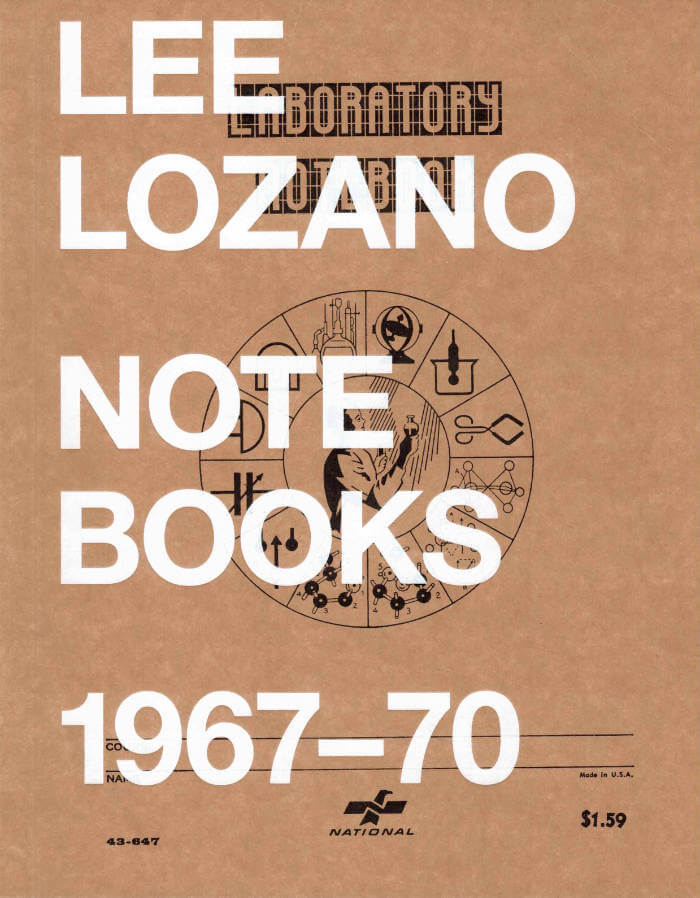
Notebooks 1967-70
This publication is a compilation of Lee Lozano’s notebooks from 1967 to 1970. The three notebooks included here contain her seminal “Language Pieces” and drawings for her paintings, including 12 studies for her 11-panel masterpiece, “Wave Series.”
Lee Lozano (1930-1999) was an enigmatic artist making a diverse body of drawings, paintings, and conceptual works. While prolific, her production was limited to her time in New York from the early 1960s to the early 1970s. She was very actively engaged with other artists in New York until she decided to leave the art world in 1972. Until recently, much of her work has been difficult for the public to access. From the time of her boycott of the art world until her death, Lozano was an artist working conceptually even though she did not participate actively in the commercial art world for the last three decades of her life.
The pages of the notebooks contain notes and sketches related to her abstract paintings and also contain her texts, which were known as “Language Pieces.” The artist’s work in the books reveal her desire to live and create art within a structured system. Lozano considered the individual pages of her notebooks to be drawings, and they were sometimes separated and exhibited. Twenty-five years ago, the notebooks were photocopied and it is that record which serves as the basis for this book.
Notebooks 1967-70 was first published by Primary Information in 2010. This is the second printing.
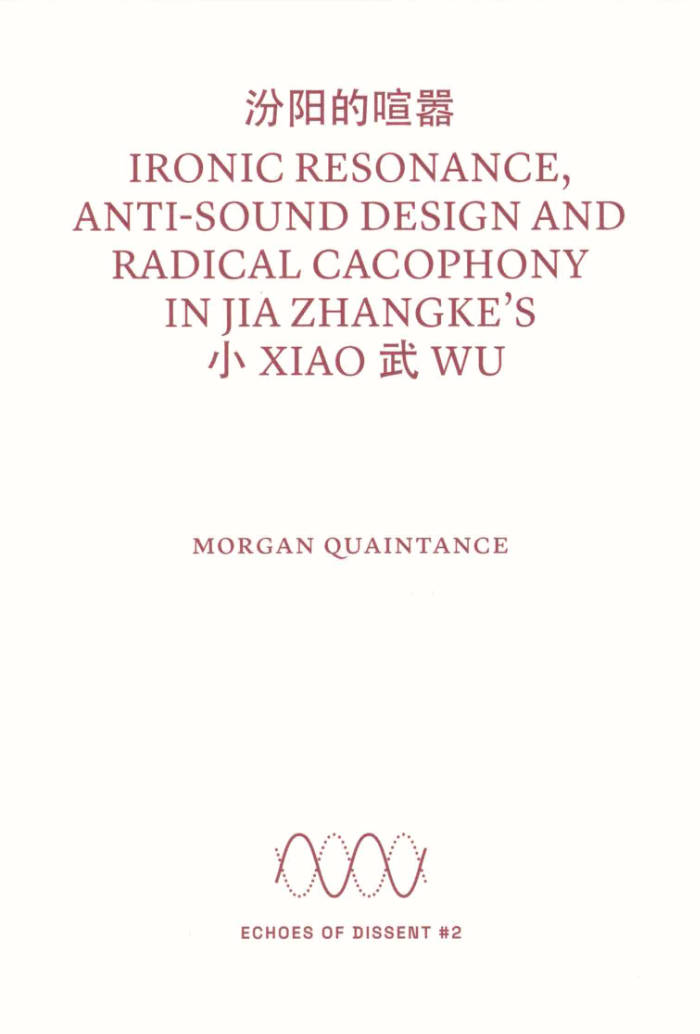
Ironic Resonance, Anti-sound Design and Radical Cacophony in Jia Zhangke's Xiao Wu
In the context of The Skin of the World program at Courtisane festival 2024, Morgan Quaintance was invited to reflect on the use of sound in Jia Zhangke’s Xiao Wu (Pickpocket).
This is the second publication in the Echoes of Dissent series, devoted to the politics of the soundtrack.

The Clip-On Method
The Clip-On Method is THE book on the work of Cady Noland everybody was waiting for but nobody expected. Two volumes, almost 600 pgs, that gather a minute, specific, documentation of the artist’s works (“often shown within their first installations,” from 1984 onwards) and further unfold the issues and questions that form the core of her practice and structure her engagement in art – without imposing any interpretation, critical perspective, other than the one proposed (suggested) by the artist’s own approach to the book form.
Book 1 gathers documents, essays, sholarly texts and articles regarding capitalism, violence, aircraft industry, racial discrimination in US universities, amongst various issues, interspersed with pictures of the artist’s works.
In Book 2 there are more photographs along with an exciting, impressive collection of writings by Noland (including, of course, “Towards a Metalanguage of Evil”). Most of the texts, and several of the pictures as well, are presented as facsimiles, laying out the work process, and the origins of what forms that sum.
Design by Cady Noland, Will Holder
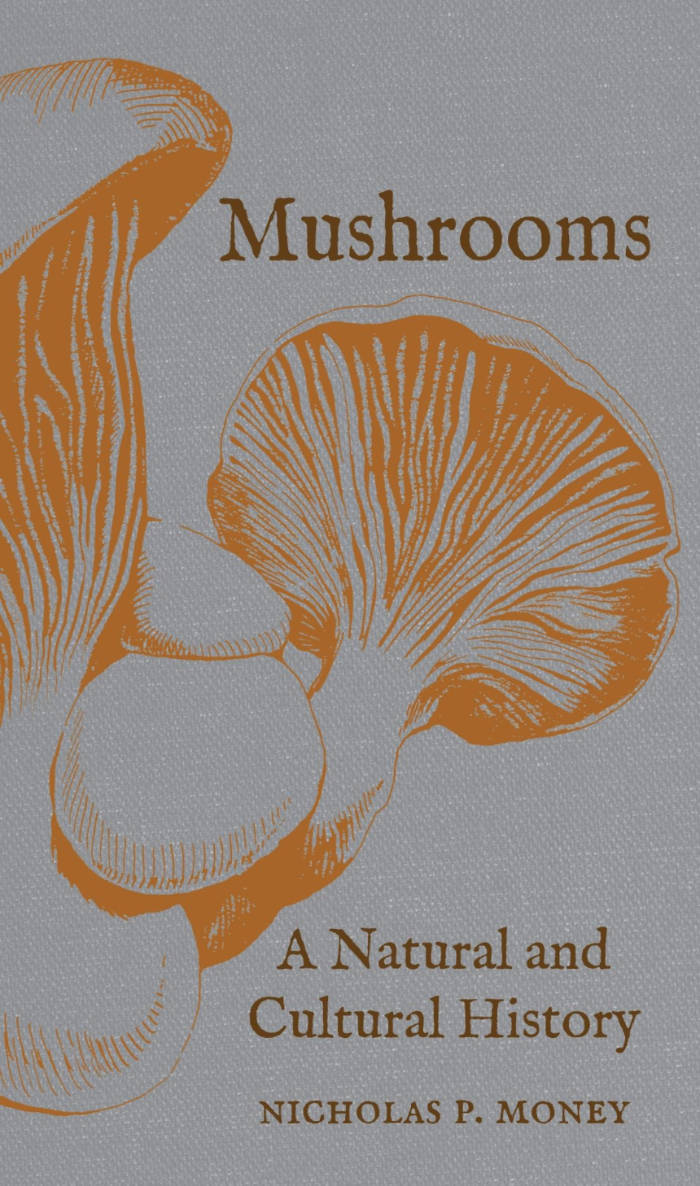
Mushrooms: A Natural and Cultural History
Mushrooms hold a peculiar place in our culture: we love them and despise them, fear them and misunderstand them. They can be downright delicious or deadly poisonous, cute as buttons, or utterly grotesque. These strange organisms hold great symbolism in our myths and legends. In this book, Nicholas P. Money tells the utterly fascinating story of mushrooms and the ways we have interacted with these fungi throughout history. Whether they have populated the landscapes of fairytales, lent splendid umami to our dishes, or steered us into deep hallucinations, mushrooms have affected humanity from the earliest beginnings of our species.
As Money explains, mushrooms are not self-contained organisms like animals and plants. Rather, they are the fruiting bodies of large—sometimes extremely large—colonies of mycelial threads that spread underground and permeate rotting vegetation. Because these colonies decompose organic matter, they are of extraordinary ecological value and have a huge effect on the health of the environment. From sustaining plant growth and spinning the carbon cycle to causing hay fever and affecting the weather, mushrooms affect just about everything we do. Money tells the stories of the eccentric pioneers of mycology, delights in culinary powerhouses like porcini and morels, and considers the value of medicinal mushrooms. This book takes us on a tour of the cultural and scientific importance of mushrooms, from the enchanted forests of folklore to the role of these fungi in sustaining life on earth.

Amateur
Amateur is the first comprehensive publication about Wendelien van Oldenborgh’s moving-image work and accompanying installations. Developed over the past ten years, these works explore communication and interaction between individuals, often set against the backdrop of a unique public location in order to cast attention towards repressed, incomplete, and unresolved histories. Through the staging of these encounters in film, Van Oldenborgh enables multiple perspectives and voices to coexist, and brings to light political, social, and cultural relationships and how they are manifested through social interactions. The publication is generously illustrated and brings together a wealth of texts by artists, curators, and writers who have been key interlocutors with Van Oldenborgh, and offer in-depth observations and reflections on a work from her oeuvre.
Contributors: Nana Adusei-Poku, Ricardo Basbaum, Frédérique Bergholtz, Eric de Bruyn, Binna Choi, David Dibosa, Denise Ferreira da Silva, Avery F. Gordon, Tom Holert, Nataša Ilić, Charl Landvreugd, Sven Lütticken, Anna Manubens, Ruth Noack, Grant Watson.
Design: Julia Born
Publishers: If I Can’t Dance; The Showroom, London; and Sternberg Press, Berlin

FUKT #19 – The Storylines Issue
Founded in 1999 by artist Bjørn Hegardt, FUKT, which translates to “moist” or “damp” in Norwegian and Swedish, is an annual magazine for contemporary drawing based in Berlin and Oslo. Each issue comes with a unique cover by Ariane Spanier who also co-edits and designs the magazine. From issue 16 onwards, the FUKT team began organising each edition thematically: from The Sex Issue on Dirty Drawings to The Words Issue and Fukt The System Issue.
The theme of the storyline in this edition has been interrogated in a number of ways, taking the reader on a journey from the mythical, to the sequential and the storyboard. For Hegardt, the thread that unites all of the featured artists is that “above all, they are people who create drawings with beautiful, surprising, funny or sad stories. Like always in our magazine, everything revolves around our beloved practice of drawing.
Artists: Adéla Marie Jirku, Bjørn Bjarre, Brian Rea, Byun Young Geun, Chris Ware, Colin Matthes, Danielle Morgan, Davor Gromilović, Emma Talbot, Gareth Fuller, Jana Gunstheimer, Johannes Høie, Maria Medem, Maria Paz, Marie-Louise Ekman, Miodrag Manojlović, Océane Moussé, Ori Toor, Sakubei Yamamoto, Shuvinai Ashoona, Toyin Ojih Odutola, WOSHIBAI, Yuichi Yokoyama, Xiyu Tomorrow

Silicone God
Shae wants to stop shagging other women's husbands and be a proper queer. Plus, she's bored of only ever getting to use her new strap on a pile of cushions. The answer seems simple enough: come out, go out, and finally get it on with the fit bird at Dyke Night. Or it would be if Evaline, a wayward silicone mistress from the future, wasn't jealous...
A surreal, dirty little book that falls somewhere between Derek McCormack, David Cronenberg, and the tentacle porn you 'accidentally downloaded', Silicone God is for those who like it very, very weird.

Meditations
A manual of meditations on grief blocked by trauma, pliers, goats, remedies, meaning, conduits, suicide, eggs, times, tutting, God, lifts, treasury tags, wrecking yards, Douglas Barrowman, involuntary spasms, front desks, manganese deficiency, weevil shit, Mr Sheen, coal potential, the bison, The Final Cut, tone of voice, trillions of cicadas, Elisabeth Koolaart-Hoofman, bogus antler cannibalism, the Preces Gertrudianae, parodies of communication, “Cary Grant’s Wedding,” the corruption of youth, a tripod or cable, Culverwell on the Vacuola, geese, Hemans’s line on Mary Tighe, annihilation, the proletariat, plastic bags, La Compiuta Donzella di Firenze, poetry, rooms, beheadings, S106 obligations, and planks. Containing single, double, triple, and sextuple sestinas, in the old mode of retrogradatio cruciata, and other canzoni, crushed to prose.

GLEAN - Issue 5 (NL edition)
De vijde Nederlandstalige GLEAN editie.
Bijdrages over Chantal Akerman, Biënnale van Venetië, Eline de Clercq, Samah Hijawi, Laure Prouvost, Anastasia Bay, Wim Delvoye, Riar Rizaldi, Haegue Yang, Nil Yalter, Anna Maria Mariolino.

Octopus notes #11
Baptiste Pinteaux, Martin Laborde and 1 more
The eleventh issue of the journal-collection that brings together academic writings, interviews with artists, critical essays and artists' interventions in the form of inserts.
Featuring: Madalena Anjos, Zoe Beloff, Jean-Claude Biette, Vittoria Bonifati, Christine Burgin, Moyra Davey, Migle Dulskyte, Martha, Edelheit, Hélène Giannecchini, Donna Gottschalk, Birgit Hein, Gaëlle Hippolyte, Megan Hoetger, Jacques Julien, Sophie Lapalu, Sibylle de Laurens, Anne Lefebvre, Liz Magor, Andrea Mazzella, Marlene Monteiro Freitas, Zibuntas Miksys, Vali Myers, Gaspard Nectoux, Jeffrey Perkins, Elisa Pône, James Robert Baker, João dos Santos Martins, Giovanna Scotti, Samuel Steward, Billy Sullivan, Sabrina Tarasoff, Paul Thek, and a long previously unpublished conversation (50 pages) between Paul McCarthy and Sabrina Tarasoff.
Octopus notes is a journal that gathers critical essays, academic writing, interviews, archival documents and artists' projects since 2013. Each issue exists without a theme, but shapes echo through its content.

Groove, Bang and Jive Around
New edition of Steve Cannon's riotous 1969/71 erotic novel Groove, Bang and Jive Around, "an underground classic of such legendary stature that New York's black cognoscenti have transmogrified the work into urban myth," with a foreword from Darius James and an afterword by poet Tracie Morris.
Despite decades of notoriety as one of the "filthiest books in the world," Steve Cannon's first and only novel, Groove, Bang and Jive Around, has hardly been read since first being published by the Paris- based Ophelia Press in 1969.
Due to its scarcity, the New York Press deemed it "an underground classic of such legendary stature that New York's black cognoscenti have transmogrified the work into urban myth." This debut, revised for release by Olympia Press in 1971, cemented Cannon's place as a stalwart of the East Village and key figure in New York's black avant-garde—inspiring a generation to break with staid literary modernism, according to Cannon's friend and collaborator Ishmael Reed, for whom its release "signaled a resurfacing of the irreverent, underground trickster tradition of black orature." Seeped psychedelia and hoodoo, this erotic farce follows Anette, a fourteenyear- old runaway, from the outhouse of a New Orleans juke joint to the land of Oo-bla-dee, a realm of bacchanalian self-determination founded by Dizzy Gillespie. Inspired equally by Chester Himes and Women's Liberation, the author claims—as Ophelia put it, Groove, Bang and Jive Around is an absolute necessity "for everyone who wants to know where and how the action takes place in Sex and Soul."
"If there's a dirty prayer, this is it. Groove, Bang and Jive Around will invariably piss people off, that's the plan and its delight. It's gorgeously uneven, like a country road, it's squawking & sonorous like great live music, indeed, it is that. Groove, Bang is poetry and a novel out loud, and Steve Cannon, who wrote it was a huge heckler and a funny man and I wish I could thank him for this wonderful disturbing, deeply wrong (hot) and light-footed book that somehow fell out of reading history he has given us and now it has fallen back in."—Eileen Myles, author of a Working Life
Steve Cannon (1935-2019) was a writer who shaped the literary history of Manhattan's Lower East Side. He was the founder and executive director of A Gathering of the Tribes, an East Village nonprofit and exhibition space, and the publisher of a magazine of the same name. Tribes, which operated from Cannon's Alphabet City townhouse, functioned as a salon where artists and musicians such as David Hammons, Sun Ra, and Butch Morris could reliably be found among a cohort of younger poets emerging from the Nuyorican Poets Café scene. Born to a preacher in New Orleans, Cannon relocated to New York from England in 1962, where, alongside such luminaries as Amiri Baraka and Calvin C. Hernton, Cannon joined the Umbra Workshop, a cornerstone of the 1960s African American avant-garde poetry and publishing. In 1973 he, Ishmael Reed, and Joe Johnson cofounded the influential literary and audio/visual imprint Reed, Cannon, and Johnson. As a poet, playwright, and professor, Cannon mentored a generation of writers including Eileen Myles and Paul Beatty, and taught across the City University of New York system for more than three decades.
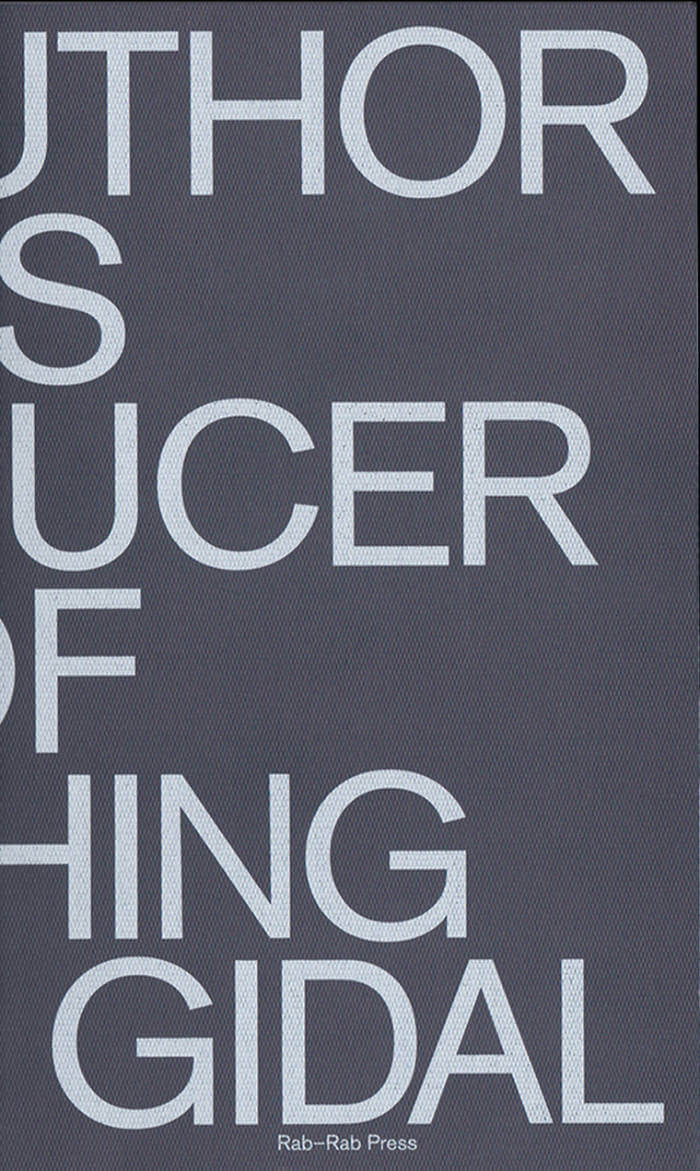
The Author as Producer of Nothing
The first publication of a lost 1978 text by Peter Gidal—one of the most influential experimental filmmakers ever.
The book includes the first publication of Peter Gidal's text from 1978, with a new introduction. Gidal in this dense theoretical essay deals with the limits of language and representation in the practice of experimental filmmaking and writing. Gidal's lost text The Author as Producer of Nothing will give a new insight into the theoretical and political context to experimental film practices.
The afterword by Sezgin Boynik discusses in detail the political contradictions of Gidal's filmic non-objectivity.
"The process of the film's making deals with devices that result in demystification or attempted demystification of the film process. But by 'deals with' I do not mean 'represents'. In other words, such films do not document various film procedures, which would place them in the same category as films which transparently document a narrative, a set of actions, etc. Documentation, through usage of the film medium as transparent, invisible, is exactly the same when the object being documented is some 'real event', some 'film procedure', some 'story', etc. An avant-garde film defined by its development towards increased materialism and materialist function does not represent, or document, anything. The film produces certain relations between segments, between what the camera is aimed at and the way that 'image' is presented. The dialectic of the film is established in that space of tension between materialist flatness, grain, light, movement, and the supposed reality that is represented. Consequently a continual attempt to destroy the illusion is necessary."—Peter Gidal
Peter Gidal (born 1946 in New York) is an influential British film theorist and avant-garde filmmaker, associated with the English "Structural/Materialist" movement (along with Malcolm Le Grice notably). He has published in numerous magazines (Studio International, Screen, October, Undercut) and is the author of several books, including Andy Warhol: Films and Paintings (1971), Materialist Film (1988) and Understanding Beckett: A Study of Monologue and Gesture in the Works of Samuel Beckett (1986).

Scrapbook – 40 ans de Light Cone
A visual anthology compiling the contributions of the filmmakers who are part of the Light Cone collection, a key institution for the distribution, promotion and preservation of experimental cinema in France and around the world, on the occasion of its 40th anniversary.
2022 marks an important moment for Light Cone: its 40th anniversary. Such an event should be celebrated in the best possible way. Light Cone has come together thanks to the filmmakers whose films entered the collection over the years. We've decided to invite them to participate in an editorial project, a book in which we would publish their contributions: letters, postcards, photographs, drawings, film stills, collages, etc., which they have sent us for the occasion of the anniversary. A collective scrapbook in which the materiality of the objects—paper, photos, colors, handwritten notes—evokes that of analog cinema, which we have always defended. A book of images is born, and through the creation of this micro-collection, so is a portable museum of about one hundred pieces, which are ready to be exhibited and which will remain in the care of Light Cone's archive.
With Michel Amarger, Martin Arnold, Caroline Avery, Peter-Conrad Beyer, Giuseppe Boccassini, Patrick Bokanowski, Louise Bourque, Robert Breer, Dietmar Brehm, Claudio Caldini, Stefano Canapa, Abigail Child, Pip Chodorov, Martha Colburn, Philippe Cote, Sandra Davis, Frédérique Devaux, Karel Doing, Anja Dornieden, Flatform, Cécile Fontaine, Olivier Fouchard, Su Friedrich, Siegfried Alexander Fruhauf, Peter Gidal, Milena Gierke, Christoph Girardet, Juan David, Gonzalez Monroy, Christophe Guérin, Nicky Hamlyn, Barbara Hammer, Teo Hernandez, Tony Hill, Mike Hoolboom, Jakobois, Larry Jordan, Patrice Kirchhofer, Maria Kourkouta, Alexandre Larose, Christian Lebrat, Emmanuel Lefrant, Maurice Lemaître, Jeanne Liotta, Rose Lowder, Johann Lurf, Pablo Marín, Mara Mattuschka, Bruce Mcclure, Miles Mckane, Luc Meichler, Barbara Meter, Peter Miller, Matthias Müller, Michel Nedjar, Dominique Noguez, Vivian Ostrovsky, Simon Payne, Emmanuel Piton, Charlotte Pryce, Gisèle Rapp-Meichler, Abraham Ravett, Emily Richardson, D.N. Rodowick, Gaëlle Rouard, Martine Rousset, Pierre Rovere, Ben Russell, Daïchi Saïto, Maki Satake, Sylvia Schedelbauer, Jeff Scher, Stanley Schtinter, Guy Sherwin, José Antonio Sistiaga, John Smith, Vicky Smith, Michael Snow, Malena Szlam, Mika Taanila, Marcelle Thirache, Trinh T. Minh-ha, David Wharry, Telemach Wiesinger, Antoinette Zwirchmayr.
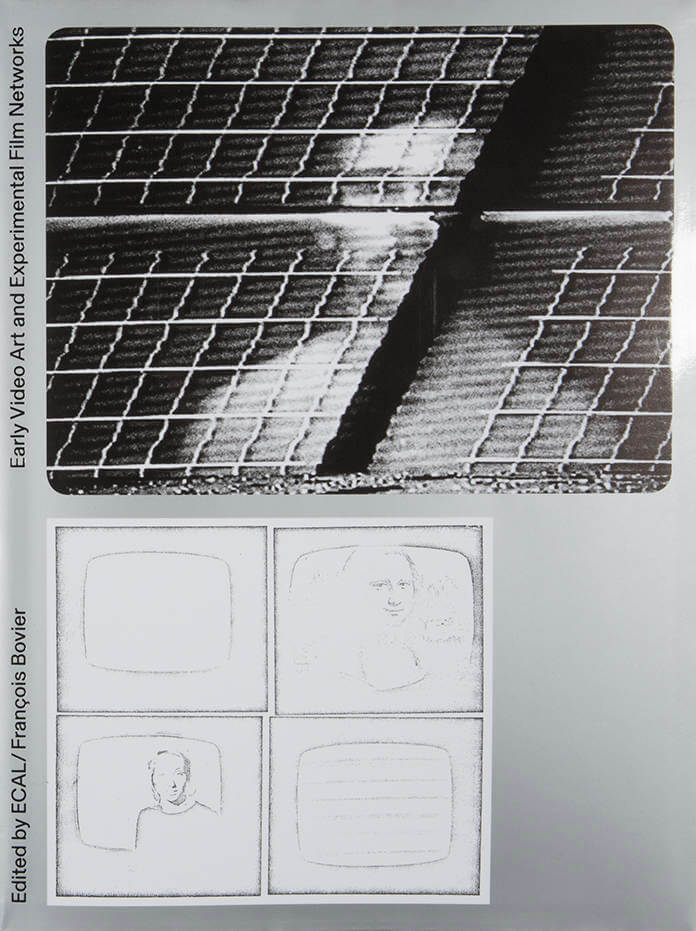
ECAL (Lausanne University of Art and Design)
Early Video Art and Experimental Films Networks
An international history of video art and experimental cinema networks in the early 1970s: the volume casts a new eye on various exhibitions, broadcasts and production and distribution structures, including a case study on Jonas Mekas' Anthology Film Archives.
Early Video Art and Experimental Films Networks traces the diffuse international networks through which video art and experimental films circulated during the late sixties and early seventies. It explores forgotten exhibitions both in Switzerland and France, the activities of public television channels and alternative art spaces in the US, a production art center dedicated to video in Italy and an Argentinian collective of conceptual artists, aiming to shed new light on the production and diffusion of moving images.
This volume is divided into two parts: the first part, which is longer and more extensively documented, explores the emergence and consolidation of video art networks at international level; the second focuses more specifically on two exhibitions of artists' films (New Forms in Film and Une histoire du cinéma) and one of the main instances of the museification of experimental cinema, Anthology Film Archives. Indeed, this particular story has wider currency insofar as several important works in recent years have focused on artists' films 23 and expanded cinema 24. We have adopted the principle, wherever possible, of providing rare and previously unpublished images and documents alongside the essays specifically commissioned for this volume, the choice of which has been left to the discretion of the author of each particular chapter.
Texts by Kristen Alfaro, François Bovier, Enrico Camporesi, Katarzyna Cytlak, Larisa Dryansky, Tristan Lavoyer, Adeena Mey, Kris Paulsen, Cosetta G. Saba, Andrew V. Uroskie.
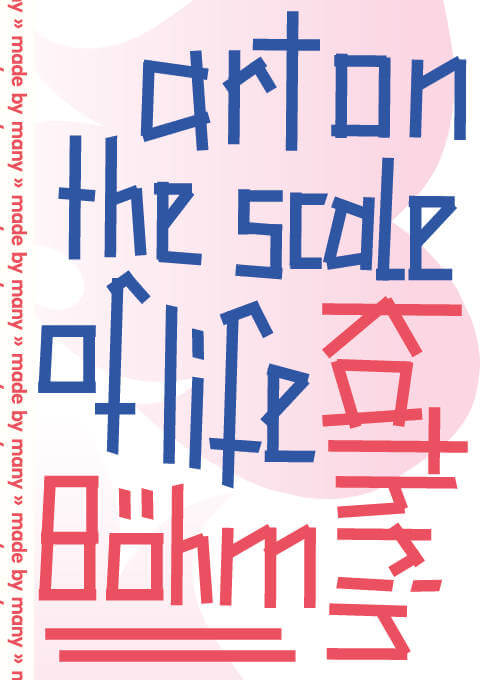
Art on the Scale of Life
A comprehensive overview of artist Kathrin Böhm's multifaceted, deeply collaborative, and durational practice and networks.
This volume critically profiles, contextualizes, and theoretically elaborates the unique practice of the UK-based German artist Kathrin Böhm. Combining visual and textual material, it offers an overview of Böhm's exceptional modus operandi that is rooted in a highly original artistic synthesis of a range of practices. Over the last three decades, Böhm has expanded the terms of socially engaged ways of working to an unprecedented scale and breadth by producing complex organizational, spatial, visual, and economic forms. These often entail the production of complex infrastructures, manifested via projects such as Culture is a Verb (2018–21), The Centre for Plausible Economies (2018–ongoing), Company: Movements, Deals and Drinks (2014–ongoing) and the Eco-Nomadic School (2010–ongoing). The book follows a major mid-career exhibition at The Showroom, London, in 2021.
Offering a significant addition to debates on contemporary art and architecture, social action, and public culture, Kathrin Böhm: Art on the Scale of Life brings together critical reflections by internationally acclaimed contributors. Spanning a wide range of critical positions and disciplines, these include Dave Beech, Céline Condorelli, Elvira Dyangani Ose, Wapke Feenstra, Katherine Gibson, Joon-Lynn Goh, Lily Hall, Yolande Zola Zoli van der Heide, Grace Ndiritu, Gerrie van Noord, Paul O'Neill, Doina Petrescu, Gregory Sholette and THEMM!!, Kuba Szreder, Gavin Wade, Mick Wilson, Stephen Wright, and Franciska Zólyom. In addition, material derived from Böhm's international networks and projects provides an in-depth impression of the deeply ingrained collaborative and durational nature of her way of working.
Photographic, diagrammatic, and typographical imagery runs through the book, demonstrating the rich visual and spatial languages embedded in Böhm's work. This visual register of the book is therefore much more than a series of illustrations and acts as a counterpoint to, and extension of, the ideas elaborated in the texts.
Kathrin Böhm is an international artist based in London. Her work takes place in and outside the art world, as she engages with governance, economics and different trans-local communities. Her main interests are the collective (re-)production of public space, trade as public realm and the everyday as a starting point for culture.
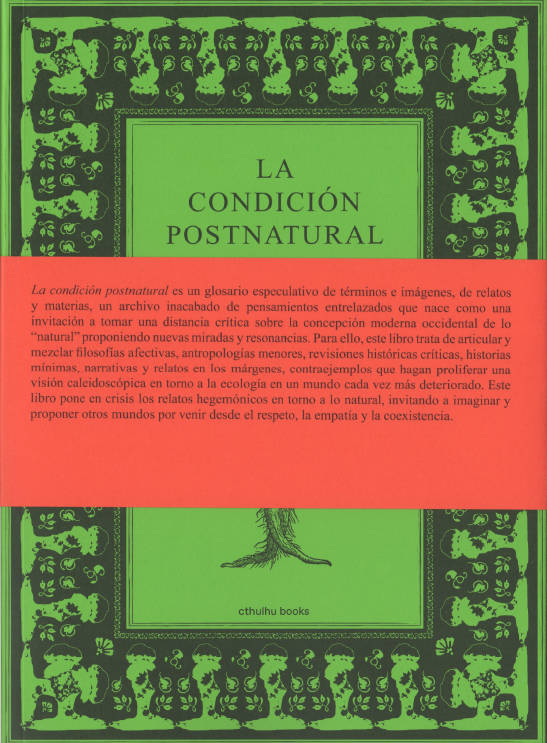
La condición postnatural
What is postnature? How to understand the socio-climatic crisis and where to look for new narratives for a desirable future? What is the relationship between contemporary ecology and artistic practices? The postnatural condition is a speculative glossary of terms and images, of stories and materials, an unfinished archive of intertwined thoughts. This book, which includes theoretical texts, situated examples, and artistic projects, presents a critical view of the modern Western conception of the "natural" and proposes new perspectives and resonances. Mixing affective philosophies, minor anthropologies, critical historical revisions, minimal histories, narratives, and stories on the margins, it seeks to proliferate a kaleidoscopic vision around ecology in an increasingly deteriorating world, inviting us to imagine and propose other worlds to come from respect, empathy, and coexistence.
Texts by Gabriel Alonso & Clara Benito with collaborators: Paloma Villalobo, Valentín Bansac, Nicolás Sánchez, Fionn Duffy, Aitor Frías, Andra Lena, Pop Juri, Geerts Dana, Lorenzo Galgó, Maria Morata, Valeria Mata, Maya Pita-Romero, Lily Chishan Wong, Sina Sohrab, Davide Marcianesi, Preethisakana Mathiseka, Alessandro Pasero, Anna Raffaghello, Ludmila Secchin, Federico Dopazo, Alba Noguera.
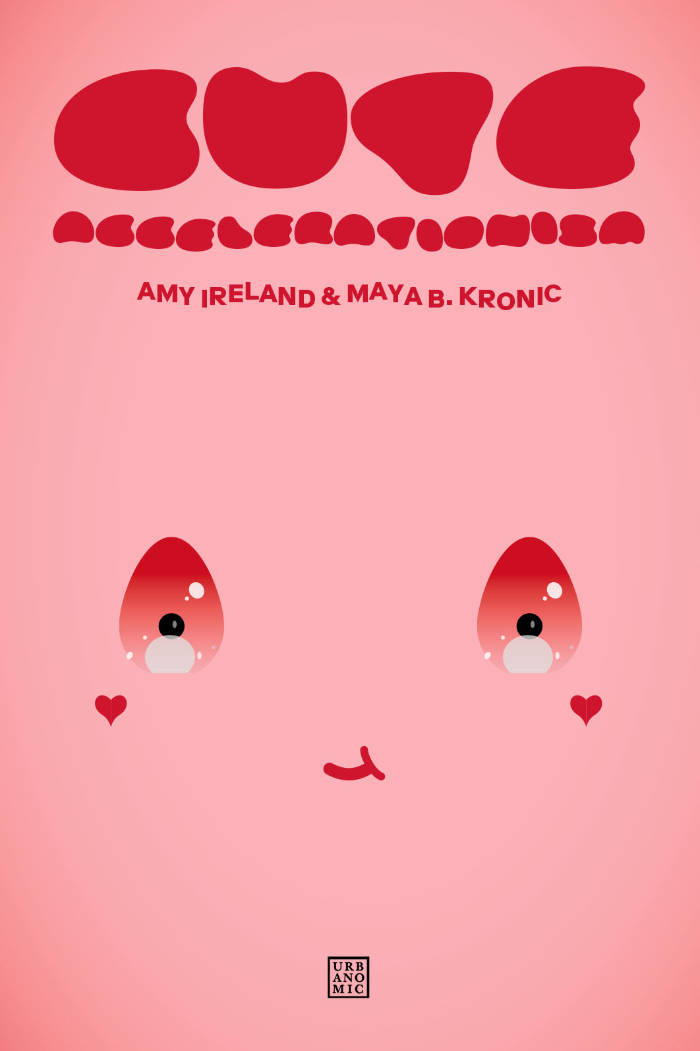
Cute Accelerationism
Involuntarily sucked into the forcefield of Cute, Amy Ireland and Maya B. Kronic decided to let go, give in, let the demon ride them, and make an accelerationism out of it—only to realise that Cute opens a microcosmic gate onto the transcendental process of acceleration itself.
Joining the swarming e-girls, t-girls, NEETS, anons, and otaku who rescued accelerationism from the double pincers of media panic and academic buzzkill by introducing it to big eyes, fluffy ears, programming socks, and silly memes, they discover that the objects of cute culture are just spinoffs of an accelerative process booping us from the future, rendering us all submissive, breedable, helpless, and cute in our turn. Cute comes tomorrow, and only anastrophe can make sense of what it will have been doing to us.
Evading all discipline, sliding across all possible surfaces, Cute Accelerationism embraces every detail of the symptomatology, aetiology, epidemiology, history, biology, etymology, topology, and even embryology of Cute, joyfully burrowing down into its natural, cultural, sensory, sexual, subjective, erotic, and semiotic dimensions in order to sound out the latent spaces of this Thing that has soft-soaped its way into human culture.
Traversing tangents on natural and unnatural selection, runaway supernormalisation, the collective self-transformation of genderswarming cuties, the hyperstitional cultures of shojo and otaku, denpa and 2D love, and the cute subworlds of aegyo and meng, moé and flatmaxxing, catboys and dogon eggs, bobbles and gummies, vore machines and partial objects, BwOs and UwUs…glomping, snuggling, smooshing and squeeeeing their way toward the event horizon of Cute, donning cat ears and popping bubbles as they go, in this untimely philosophical intensification of an omnipresent phenomenon, having surrendered to the squishiest demonic possession, like, ever, two bffs set out in search of the transcendental shape of cuteness only to realise that, even though it is all around us, we do not yet know what Cute can do.
Seriously superficial and bafflingly coherent, half erudite philosophical treatise, half dariacore mashup, 100 percent cutagion, this compact lil’ textual machine is a meltdown and a glow up, as well as a twizzled homage to Deleuze and Guattari’s A Thousand Plateaus. Welcome to the kawaiizome: nothing uncute makes it out of the near future, and the cute will very soon no longer be even remotely human.
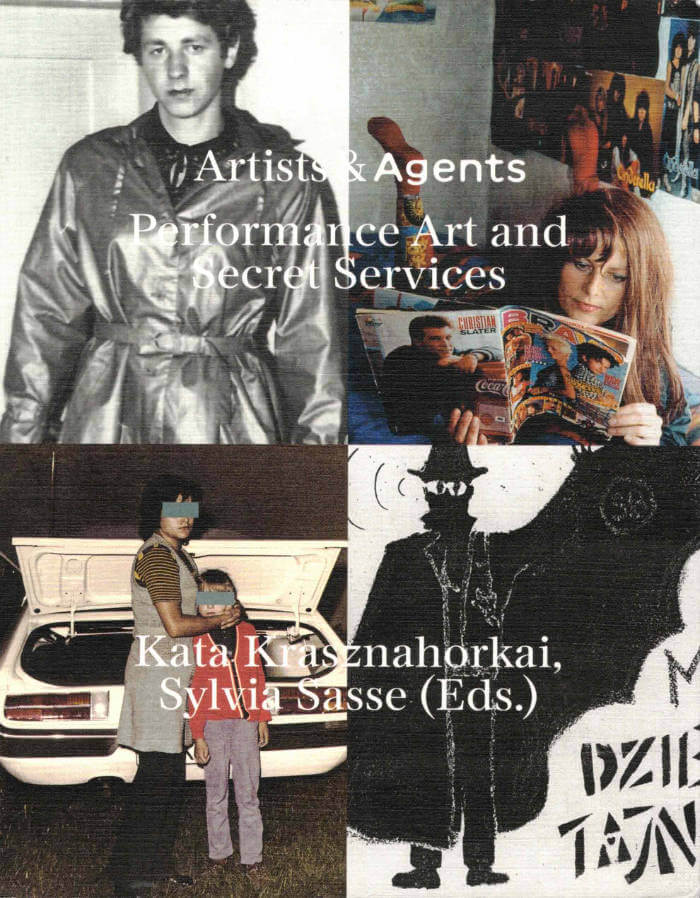
Artists & Agents. Performance Art and Secret Services
Sylvia Sasse, Kata Krasznahorkai
Subversion does not belong to anyone. It can come from artists who outwit the state or from intelligence agencies who infiltrate the art scene on behalf of the state. But what happens when the two sides meet? After the old state security archives in many Eastern European countries were opened, it became possible for this interaction to be studied in detail.
Drawing on scientific essays and artistic contributions, the book shows how the secret police monitored happenings, performance art, and action art and looks at the debates they had about the new art form; it also demonstrates not only how the police documented artistic actions in detail using forensic techniques but also how they manipulated them and sought to thwart them with counter-actions. In addition to this, the book also reveals how artists dealt with the possibility that they were being observed by the secret police and how they now work with the material stored in the archives maintained by the intelligence services.

Publi Fluor, Letter Business in Brussels
A self-taught typographic letterer, Chrystel Crickx used to cut out letters by hand and sell them by the piece in her Publi Fluor shop in Schaerbeek, Belgium. Commercialized between 1975 and 2000 for local advertising and signage purposes, these letters have since been digitized and made more widely available to users outside of the Belgian borders and in other contexts. At the margins of standard means of communication, they have contributed to shape (and still do) the urban visual landscape, in Brussels and elsewhere.
This non-standard, collective essay attempts both to recount the life of a type model — as well as of its successive authors and their tools — while expanding the field of investigation to examine the cracks between the different stories summoned up by Chrystel Crickx's practice summons up.
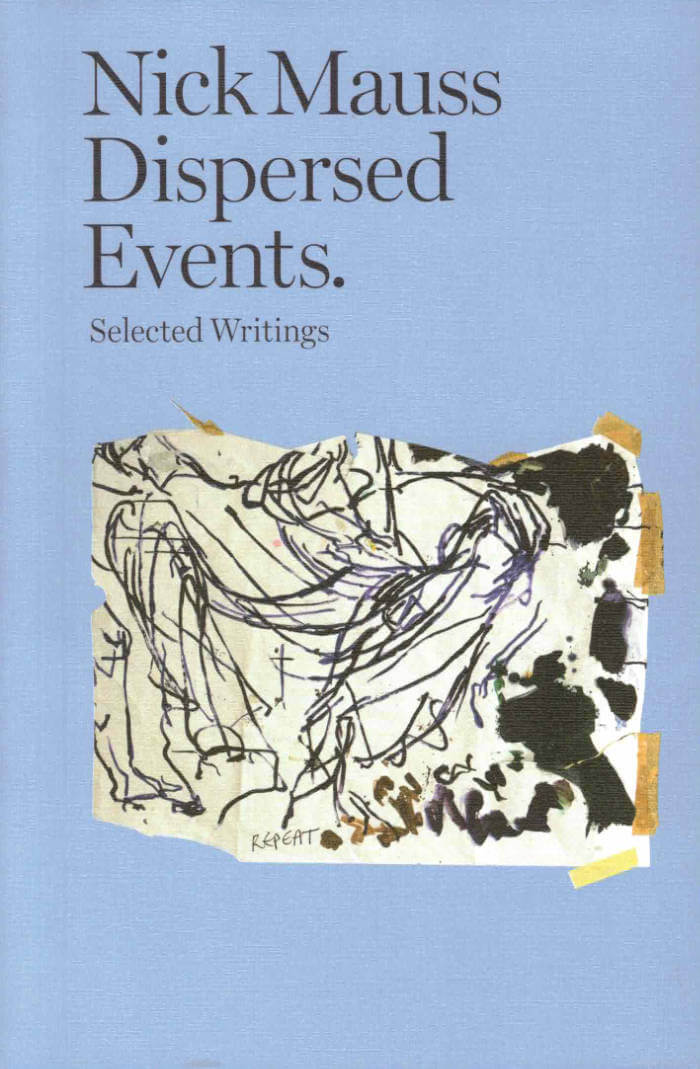
Dispersed Events. Selected Writings
Dispersed Events brings together for the first time Nick Mauss’ essays from the last fifteen years. Shimmering with the urgency of a new generation of queer thinkers, Mauss’ writing refracts contemporary art through histories of decorative art, film, theater, and dance.
An artist renowned for critically and poetically reconfiguring inherited genealogies and hierarchies of visual culture and art history, Mauss engages writing as a space for relentlessly activating counter-histories, repositioning the voice of the artist and the readers along the way. Whether he considers the practice of artist Lorraine O’Grady, the radical fashion of Susan Cianciolo, the anarcho-vaudevillian theater of Reza Abdoh, or the potential for textiles to disclose a different way of thinking, Mauss insists on the intense power of forms and feelings in their actual rather than enforced prehistories. Reevaluating experiments in fashion, dance, and the decorative arts on the same plane as painting, sculpture and cinema, he locates art as taking shape in the middle of conversations—“between art history and any afternoon.”
“Among what might initially appear, following Mauss, ‘a wildly inscrutable web of lineages,’ the reader quickly perceives unexpected, unheralded, conjunctions: affiliations, alignments, and affinities. . . . It generates a conviction that, in the best sense, is partisan. Singular, independent, illuminating.” — from the foreword by Lynne Cooke
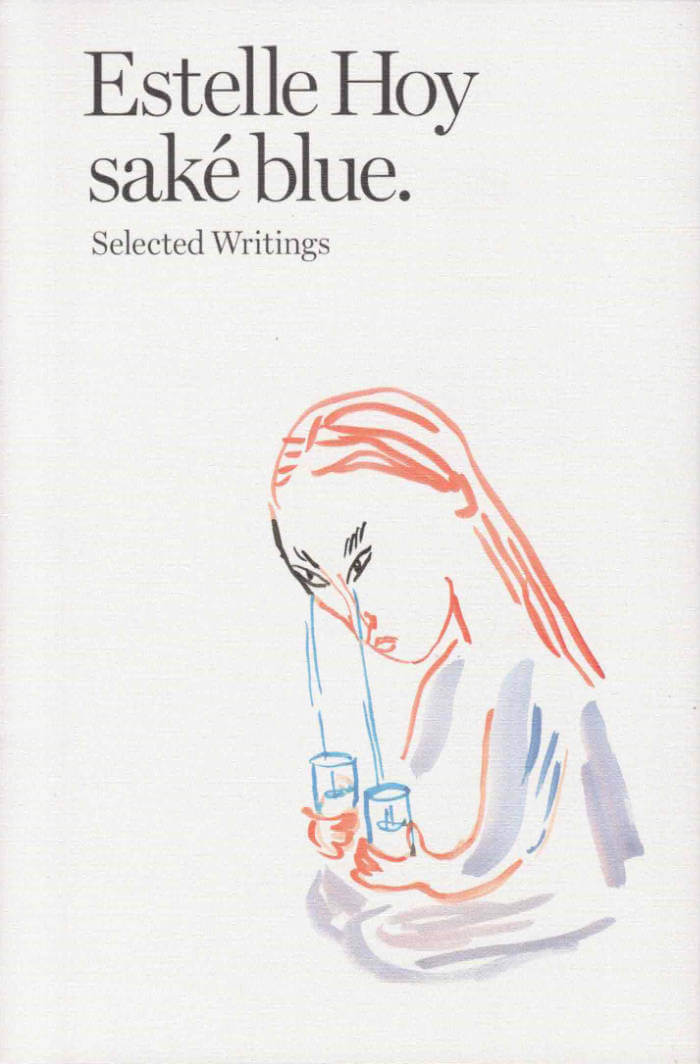
saké blue. Selected Writings
Can critical thinking spring from both a fortune cookie and Jacques Lacan’s most obscure seminar footnote? Estelle Hoy says yes. In saké blue, overpriced cheesecakes are the starting point for an essay on art writing; shoplifting in Berlin opens to a reflection on the economies of activist practices; fiction allows us to discuss the legacy of institutional critique, queer mélanges, or quiet melancholy. To her, the story of art becomes more nuanced in light of lyrics by Arthur Russell, the posthumous sorrow of Sylvia Plath, or a poem by Yvonne Rainer.
saké blue gathers critical essays, art reviews, and poetic fiction. Written in dialogue with the work of Martine Syms, Marlene Dumas, Hervé Guibert, or Camille Henrot, these texts combine the subjective and analytic, addressing power relations and the force of affect. Hoy spares nothing—and no one, exposing cultural clichés and urgent political issues through fast-paced acerbity. She advocates the work of women artists, mocks stereotypes, questions myths, and champions desire, sadness, and boredom. Simultaneously beautiful, lyrical, and cutthroat, her writing echoes to the reader like l’esprit d’escalier—we think of the perfect reply just a little too late.
“Estelle Hoy practises philosophy as an unsettled but deeply committed query into existing together. She reads, she looks, she writes, to find out something essential about the future and living for it.”
—Lisa Robertson, author of The Baudelaire Fractal
“Estelle Hoy's prose slap and bite, saké blue is a sharp pleasure to read.”
—Calla Henkel, author of Scrap
“Hoy’s renditions of all-too familiar scenes are made more visceral than life with sparkling prose and a sly attention to life’s many shifting values that feels more than appropriate for anyone truly interested in art.”
—Natasha Stagg, author of Artless
Edited by Antonia Carrara
With an introduction by Lisa Robertson

Énergies
Les sculptures et les films de Judith Hopf sont alimentés par des réflexions sur les relations que les êtres humains entretiennent avec la production et la technologie. Pour Énergies, sa première exposition monographique en France qui eut lieu conjointement à Paris à Bétonsalon et au Plateau, Frac Ile-de-France, l’artiste s’est concentrée sur cet élément invisible dont la quête accompagne notre quotidien et nos activités, produit par la conversion de ressources naturelles en puissance. Ce catalogue réunit des reproductions de dessins inédits, un entretien avec l’artiste et un texte critique de Tom Holert qui fait retour sur vingt années de travail.
Judith Hopf's sculptures and films are fuelled by reflections on the relationship human beings have with production and technology. For Énergies, her first solo exhibition in France, held jointly in Paris, at Bétonsalon and Plateau, Frac Ile-de-France, the artist focused on this invisible element whose quest accompanies our daily lives and activities, produced by converting natural resources into power. This catalog features reproductions of previously unpublished drawings, an interview with the artist and a critical text by Tom Holert, looking back over twenty years of work.
Textes / Texts
- François Aubart, Xavier Franceschi et Émilie Renard, "À propos d’énergie, d’amour et de chansons : conversation avec Judith Hopf"
- Tom Holert, "Changements de rythme : La méthodologie énergétique de Judith Hopf"
- François Aubart, Xavier Franceschi et Émilie Renard, "On Energy, Love, and Songs: Conversation with Judith Hopf"
- Tom Holert, "Changing Pace: Judith Hopf’s Energetic Methodology"
Traduction / Translation
Jean-François Caro
Louise Ledour
Typesetting : Olivier Lebrun
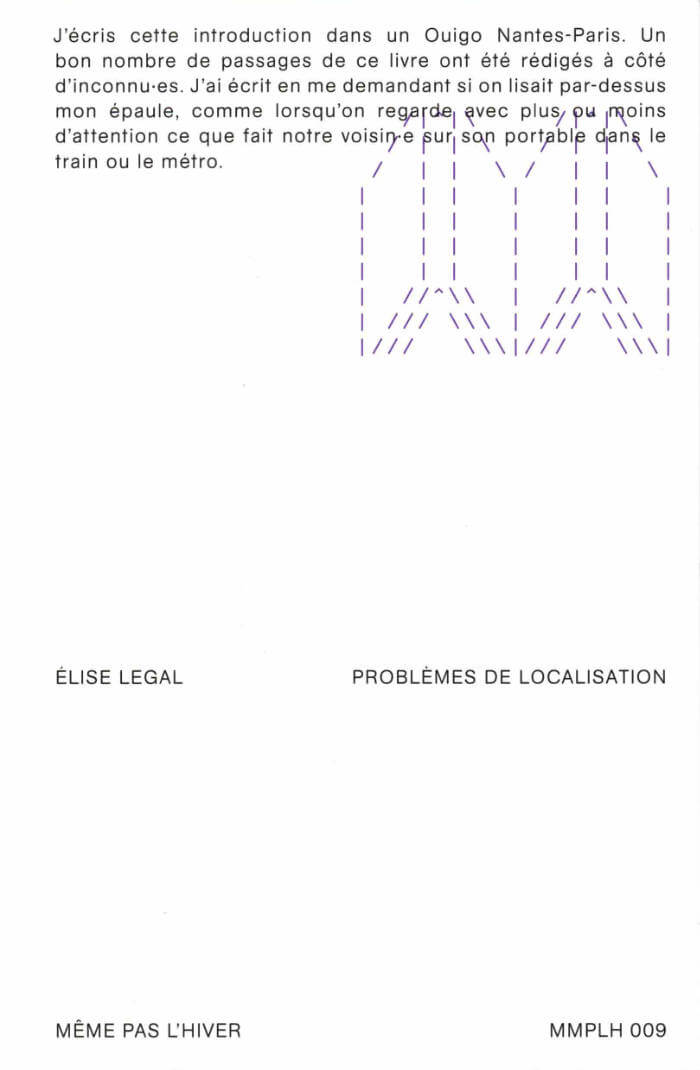
Problèmes de localisation
En sortant de l’école d’art, Élise Legal parcourt un monde de crises économiques, d’absurdités politiques et d’angoisses écologiques. Un monde dans lequel elle doit désormais légitimer sa démarche artistique dans des dossiers qui en font une fiction.
Problèmes de localisation contient sept textes, composés d’analyses critiques, de récits personnels et de poèmes, qui racontent cette entrée dans un environnement où circulent les corps, les marchandises, les informations et les capitaux. Élise Legal s’y déplace en voiture, en co-voiturage, en train, en bus ou en avion, découvrant ce que ce monde de transaction et de fluidité fait au langage. Elle cherche à comprendre comment il est incarné, échangé et habité dans les voix des pilotes d’avion, des startupers ou du président de la République, dans les textes de loi, les formulaires de demandes de bourses, la parole de ses enseigant·es, dans les textes de théorie critique comme dans la poésie des banquiers.
Élise Legal est artiste et autrice. Elle a étudié à l’École nationale supérieure des beaux-arts de Lyon et au Sheffield Institute of Arts. À travers une approche pluridisciplinaire qui mêle images trouvées, dessin et poésie, elle porte une attention particulière à la manière dont le langage et les corps coexistent. Elle poursuit également une thèse de recherche-création à Paris 8 qui porte sur l’agir politique de la poésie.
Graphisme : Olivier Lebrun